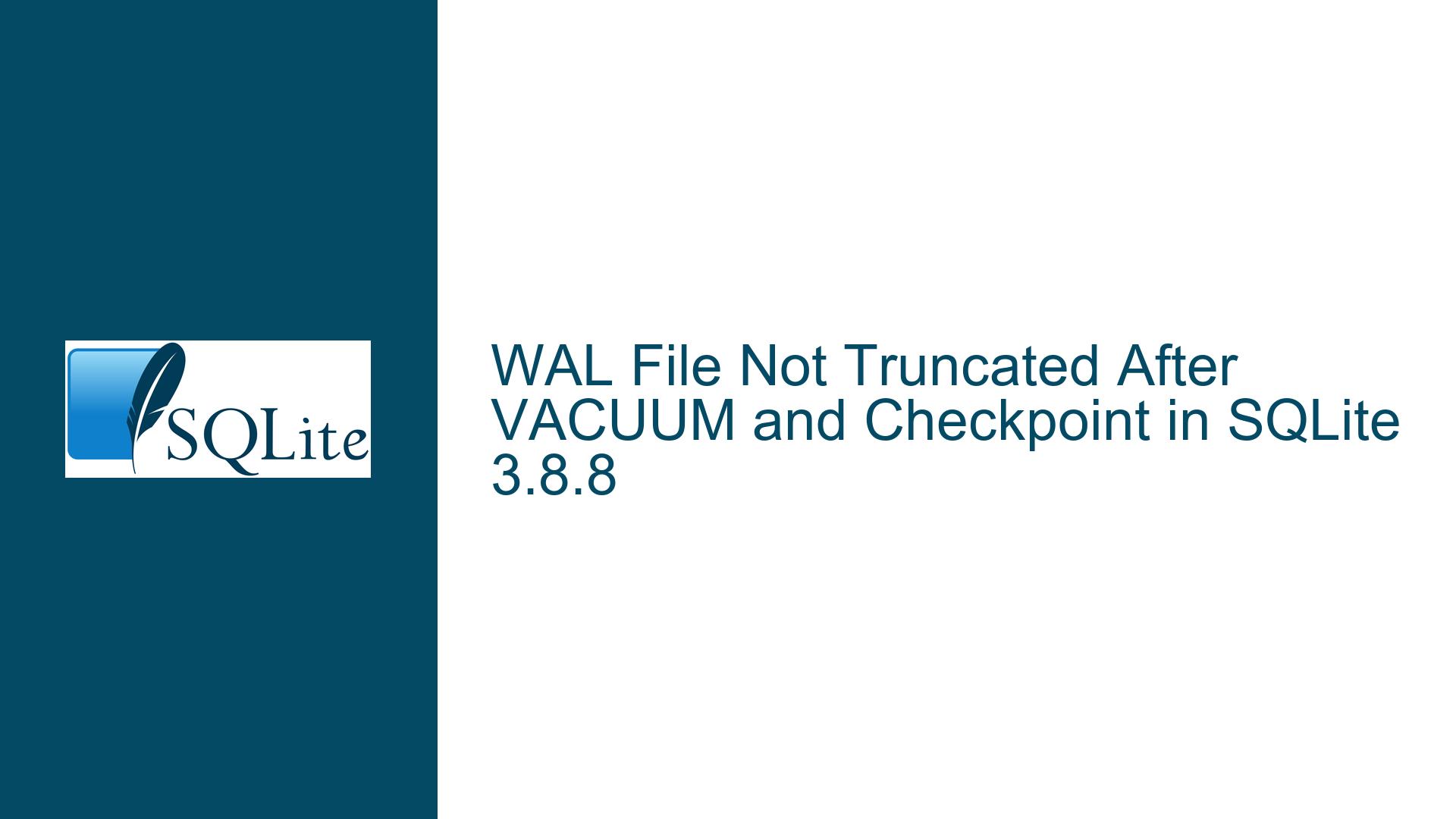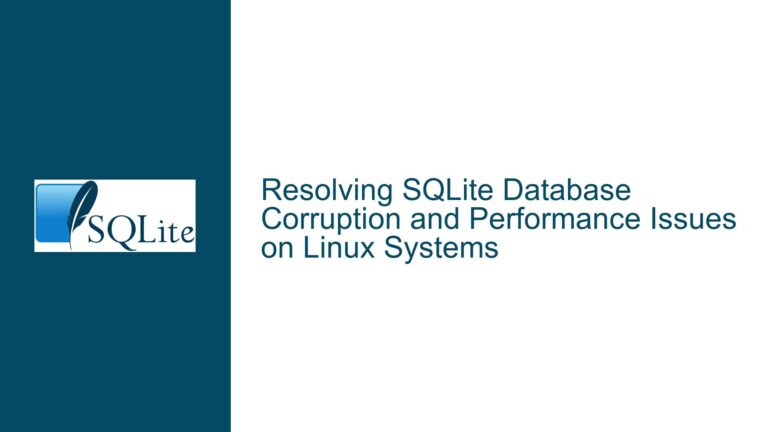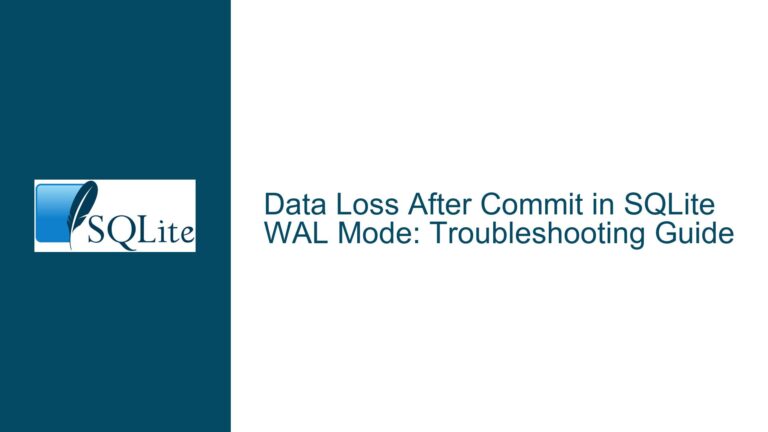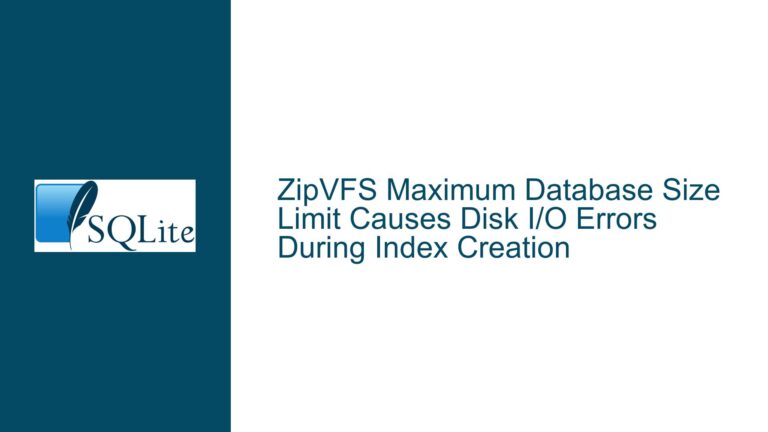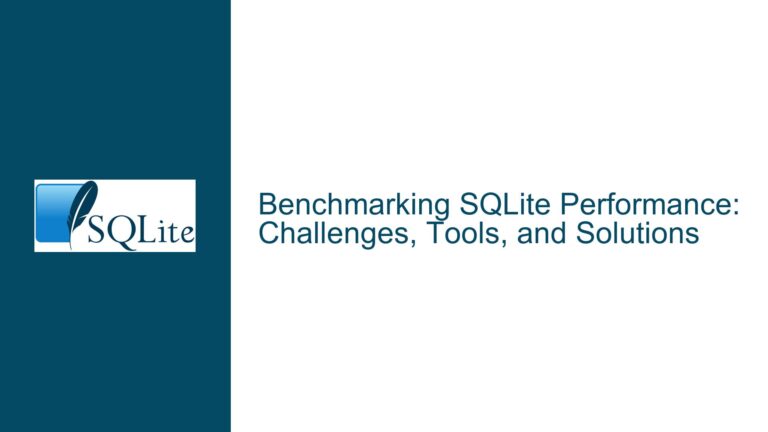WAL File Not Truncated After VACUUM and Checkpoint in SQLite 3.8.8
Understanding WAL Checkpoint Truncation Failure Post-VACUUM in Legacy SQLite
Behavior of WAL Checkpoints and VACUUM in SQLite 3.8.8
The core issue revolves around the failure of the PRAGMA wal_checkpoint(TRUNCATE) command to truncate the write-ahead log (WAL) file after executing a VACUUM operation in SQLite version 3.8.8. In this scenario, the database operates in WAL mode with synchronous=NORMAL. The workflow involves deleting old records, triggering a checkpoint to truncate the WAL, performing a VACUUM, and then attempting another checkpoint to truncate the WAL again. After the VACUUM, the WAL file size remains unexpectedly large, even though the final checkpoint is expected to reset it.
This behavior is counterintuitive because VACUUM reconstructs the database file, which should logically reduce fragmentation and release unused space. The WAL file should then be checkpointed (i.e., its contents merged into the main database file) and truncated. However, in SQLite 3.8.8, the final checkpoint fails to truncate the WAL file, leaving it at a size comparable to the main database.
Key technical elements at play include:
- WAL Mechanics: In WAL mode, changes are appended to the WAL file (
-wal) instead of overwriting the main database. Checkpoints copy these changes into the main database. TheTRUNCATEcheckpoint mode aims to reset the WAL file to zero bytes after a successful checkpoint. - VACUUM in WAL Mode: The
VACUUMcommand rebuilds the entire database, which involves creating a temporary copy of the database. In WAL mode, this operation writes all changes to the WAL file, significantly increasing its size during execution. - Checkpoint Coordination: Checkpointing after
VACUUMshould finalize the WAL changes and truncate the file. However, older SQLite versions like 3.8.8 may mishandle internal locks or transaction states afterVACUUM, preventing the WAL from being truncated.
Root Causes of Post-VACUUM WAL Truncation Failure
The failure stems from a combination of SQLite’s internal handling of checkpoints, transaction states, and version-specific quirks:
Legacy Checkpoint Implementation in SQLite 3.8.8:
SQLite 3.8.8 uses an older checkpoint algorithm that does not fully account for the transactional side effects ofVACUUM. WhenVACUUMruns, it implicitly starts and commits transactions to rebuild the database. In WAL mode, these transactions generate WAL frames that may not be fully resolved by subsequent checkpoints due to lingering internal locks or uncommitted states.VACUUM-Induced WAL Bloat:
TheVACUUMoperation in WAL mode writes all database pages to the WAL file as part of the rebuild process. This temporarily inflates the WAL file to a size comparable to the main database. However, in SQLite 3.8.8, the post-VACUUMcheckpoint may fail to recognize that all WAL frames have been integrated into the main database, leaving the file untruncated.Transaction Journal Modes and Synchronization:
Withsynchronous=NORMAL, SQLite does not guarantee that the WAL file is synced to disk immediately after writes. This can lead to scenarios where the checkpoint process incorrectly assumes that some WAL frames are still in use, even afterVACUUM. The lack of forced synchronization may leave the WAL file in a state where truncation is deferred.Version-Specific Bugs in WAL Management:
SQLite 3.8.8 predates critical fixes to WAL checkpointing. For instance, versions prior to 3.11.0 (2016) had known issues with checkpoint starvation and WAL size management. TheTRUNCATEmode, in particular, could fail to reset the WAL file if the last transaction in the WAL was not cleanly finalized.
Resolving WAL Truncation Failures in Legacy SQLite Environments
To address the issue, follow these steps:
1. Upgrade SQLite to a Modern Version (≥3.28.0):
The most effective solution is to upgrade to SQLite 3.28.0 or later, where the checkpoint logic has been refined. Modern versions handle post-VACUUM checkpoints more reliably by ensuring that all WAL frames are checkpointed and the file is truncated.
2. Validate Checkpoint Modes and Syntax:
Ensure that the wal_checkpoint pragma is invoked correctly. The syntax PRAGMA wal_checkpoint(TRUNCATE) is valid, but older documentation sometimes confuses TRUNCATE with SQLITE_CHECKPOINT_TRUNCATE (a constant used in the C API). Confirm that the SQL command matches the intended checkpoint mode.
3. Adjust the Sequence of Operations:
If upgrading is not feasible, modify the workflow to force a full checkpoint before VACUUM:
PRAGMA wal_checkpoint(FULL); -- Force a blocking checkpoint
VACUUM;
PRAGMA wal_checkpoint(TRUNCATE);
A FULL checkpoint ensures that all WAL frames are integrated into the main database before VACUUM, reducing the likelihood of residual WAL content.
4. Monitor Transaction States and Locks:
Use the sqlite3_wal_checkpoint_v2 C API (if available) to programmatically check for pending transactions or locks that might block truncation. In WAL mode, checkpoints can only truncate the WAL if no other connections are in a read or write transaction. Tools like sqlite3_db_status can help diagnose active transactions.
5. Alternative Disk Space Management Strategies:
Instead of relying on VACUUM, consider incremental space reclamation using PRAGMA incremental_vacuum. This pragma reclaims space from free pages without rebuilding the entire database, minimizing WAL bloat. Combine this with periodic checkpoints:
DELETE FROM media_table WHERE expiration_date < CURRENT_TIMESTAMP;
PRAGMA incremental_vacuum;
PRAGMA wal_checkpoint(TRUNCATE);
6. File System Validation and Synchronization:
Ensure that the file system honors truncation requests. Some network file systems or storage layers may delay or ignore file truncation operations. Test the workflow on a local disk to rule out file system issues.
7. Debugging with SQLite Internals:
For advanced users, compile SQLite 3.8.8 with debugging symbols and trace checkpoint operations using sqlite3_config(SQLITE_CONFIG_LOG). This can reveal whether the checkpoint process encounters errors or aborts prematurely due to internal state mismatches.
By systematically addressing version limitations, transaction states, and checkpoint timing, the WAL truncation failure can be resolved, ensuring efficient disk space management in SQLite-based applications.
